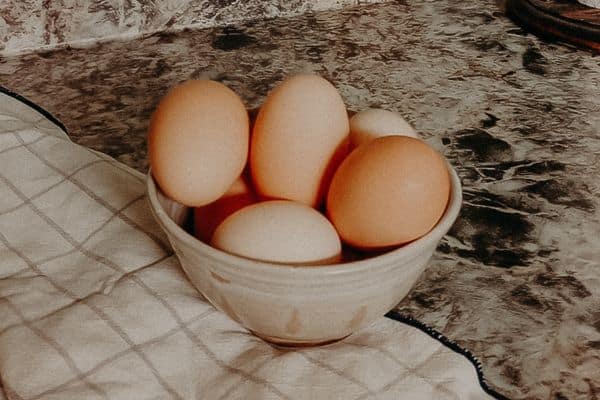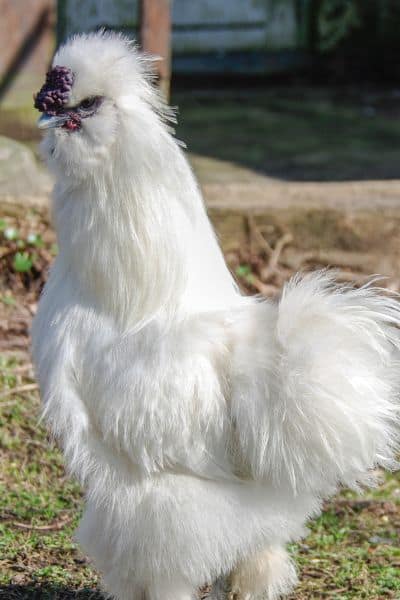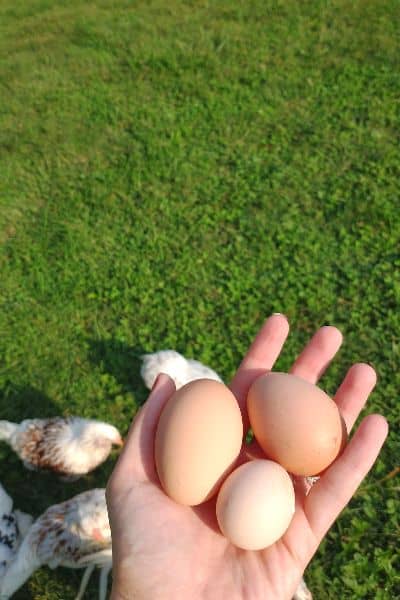How Many Eggs Does A Chicken Lay, Best Egg Laying Breeds
Whether you are simply curious about chickens or you are thinking of getting into keeping backyard chickens there are a few clarifying statements I need to make first before I can give you the answer to how many eggs does a chicken lay either each year or each week.
It depends on the breed of chicken, the hours of light the chicken is getting, and what season of life the chicken is in.
Even if you are not planning on becoming a homesteader you would always make intentional choices about the animals you keep and the projects you start. No one has infinity symbols in their bank account.
If your goal is to have a few dozen eggs per week make sure you choose the right breed that is going to produce well. Or you want to have a few chickens for fun it’s not smart to be throwing good money after bad.
While I don’t want you to hate the breed of chicken you choose to keep I also don’t want you to go about this decision willy-nilly.
Chickens are one of the main animals that doesn’t seem like it will cost you that much but the numbers add up quickly if you’re not careful.
How Many Eggs Does a Chicken Lay Each Year
When it comes to egg-laying, chickens are known for their remarkable ability to provide a steady supply of eggs. — Other poultry species like ducks and geese not so much.
However, the number of eggs an average chicken lays can vary depending on several factors. The main factor influencing egg production is the breed of the chicken.
Different breeds have different levels of productivity, with some being specifically bred for their egg-laying capabilities.
- For example, egg-laying hens can produce as many as 250-300 eggs per year if she is fed well and gets 14-16 hours of light.
- While ornamental breeds typically lay FAR fewer eggs around 110-150 eggs annually.
- Then we have dual-purpose breeds that are almost hybrid hens meant to be able to lay eggs but also be eaten if need be. And they tend to lay in the middle of the previous two types.
Age also plays a significant role in a chicken’s egg-laying capacity. You might see your first egg from a hen as young as 4 months old but young hens generally begin laying eggs consistently around six months of age and continue to lay for the next two to three years. After that, egg production may decline as the hen ages.
Free Farm Goal Planner!!!
➡️Get my proven system for choosing your farm goals so you don’t get burnt out.
The environmental conditions are critical for egg production. Chickens typically require 14-16 hours of daylight per day to maintain maximum egg production.
During the winter months when daylight hours are much shorter, many backyard chicken keepers provide artificial lighting to extend the exposure. I do this in the winter months to make sure our hens get enough light and it does very well to help extend the egg-laying cycle past the summer months.
Factors such as stress, poor nutrition, cold weather, or illness can also lead to fluctuations in egg production.

Why Egg Laying Ability Is Measured In A Year-Time
A hen’s egg-laying ability is measured in a year’s time because typically all chickens go through a season of laying less often for a few months each year. And since chickens do not lay every day at the same time of day, it’s not a consistent thing you can easily measure every time.
By measuring eggs laid over a year, we can assess the overall egg-laying capabilities of a particular breed or individual hen.
A hen’s egg-laying life is limited by the number of eggs it was born with. Each hen has a predetermined number of eggs she will produce in her lifetime, which varies based on breed and genetics.
Once a hen gets past the most productive age of 2-2.5 years old, the production rate of chickens gradually declines. While hens most continue to lay eggs beyond this point, the frequency and quantity typically decrease. This natural decline in egg-laying capabilities is influenced by factors such as genetics, weather seasons, nutritional needs, and overall health.
To maintain a steady production rate in a flock, it is common practice to replace a portion of the chickens every two to three years. By introducing new young hens, the overall productivity of the flock can be maintained.
This enables backyard chicken keepers and homesteaders to ensure a consistent supply of eggs per week.

Not All Breeds Lay The Same
Not all chicken breeds lay the same amount of eggs. Some breeds are well known for their great egg-laying abilities, while others don’t produce as many eggs.
For backyard farms or homesteads, medium to large-sized breeds with good egg-laying capacity are ideal.
These breeds tend to be more productive and can provide a steady supply of eggs.
Here are some commonly recommended breeds:
Notice I said commonly recommended, while some are great egg layers I think there are a few breeds that can do better if your main factor is egg-laying ability.
- Production Reds
- Golden Comets
- Australorps
- Leghorns
- Buff Orpingtons
- Easter Eggers.
I will get into the top egg-laying breeds in a minute but the breeds that are known for their excellent egg-laying abilities and adaptability to various conditions.
Production Reds, for example, are renowned for their high egg production and are often seen as the gold standard for backyard egg layers. — Leghorns are just a bit better at laying eggs efficiently BUT they don’t tolerate the cold as well because they are very slender-bodied birds.
Good To Poor Annual Egg Laying Range For Chickens
The range of egg production from good to poor can vary greatly among different chicken breeds.
Some of the ornamental chicken breeds tend to have a lower range of egg production, typically laying around 110-150 eggs per year. — These breeds are often kept more for their appearance rather than their egg-laying capabilities.
Which is ok to do if you keep the number to a minimum. But if you get a whole flock of these birds with no intention of raising the breed to see live birds you are going to be costing yourself a whole lot of money.
On the other hand, there are some breeds known for their exceptional egg-laying abilities. Some of today’s best egg-laying hens can produce a high range of eggs, typically around 250-300 per year. These breeds have been selectively bred to prioritize egg production.
For a shorter time span estimate a good egg-laying hen generally lay about six eggs each week, averaging around one egg every 24-26 hours. Contrary to popular belief, chickens do not lay eggs “every day. There is a common misconception that chickens lay eggs like clockwork, but this is not the case.
This peak production usually occurs during the first two years of their life. During this time, they are at their most productive.
Don’t Know Where To Start With Your Backyard Farm?
Its time to start a backyard farm that fits YOUR dream lifestyle, Backyard Farm Foundation is the answer to setting a clear plan and achievable goals for starting your dream backyard farm or homestead.
ONLY $9!!!!

The Years A Chicken Produces Eggs And Starts To Decline
A typical egg production period lasts around 2-3 years. During this time, a chicken is most productive, consistently laying a high number of eggs. However, as the years go by, the level of egg production gradually declines, along with the size and quality of the eggs.
- In the first year, hens usually lay the largest and highest-quality eggs.
- As they enter their second year, the number of eggs they produce starts to decrease slightly, and the eggs may become slightly smaller.
- By the third year, there is a noticeable decline in egg production, and the eggs may be significantly smaller in size. The shell quality may also decrease, resulting in a higher likelihood of soft-shelled eggs.
To maintain a steady egg production rate, many backyard chicken keepers and commercial flocks will be replaced every 2-3 years. Either by getting new chicks once the current flock is 2 years old or introducing younger hens that are at their peak egg-laying age. — However, this tends to cost a bit more to buy younger chickens that are a bit older already.
By implementing this practice, chicken keepers can ensure a consistent supply of eggs and offset the decline in production that occurs as hens age.
Egg Laying Chickens vs Daul Purpose Breeds
It’s easy to think that most chickens that aren’t too “fancy” should lay the same right? Well, not quite. Egg-laying chickens and dual-purpose breeds serve different purposes in backyard flocks.
Egg-laying chickens, as the name suggests, are specifically bred for maximum egg production. These breeds are selected for traits such as high egg yield, consistent egg size, and reliable laying patterns. They are efficient egg producers, and their primary focus is on providing a steady supply of eggs.
On the flip side dual-purpose chickens are raised for both meat and eggs. While they may not lay eggs as prolifically as dedicated egg-laying breeds, they are still capable of producing a decent number of eggs while also providing a source of meat. These breeds are well-rounded and are often larger and more robust in size compared to egg-laying breeds.
Top 5 Egg-Laying Chicken Breeds
There are some breeds that do well for laying eggs and some that are popular but could do a bit better. Here are the best breeds ranked by the number of eggs they lay each year. But keep in mind your locational weather conditions. If you live in the north and have harsh winters you may have to make sure your coop is warm enough to help them keep laying through the winter. If their body has to use energy to stay warm it stands to reason that you will get fewer eggs.
I have also made notes about the temperament that I have seen with these breeds. If you are not keeping the chickens in a run 24/7 you do not want a chicken breed that’s a jerk.
Leghorn (220-300 Eggs Per Year)
- Hen – 4.5. pounds
- Rooster – 6 pounds
- Purpose – Egg Laying
- Egg Color – White
- Temperament – Very Active

Known for their high egg production, Leghorn chickens lay around 280-320 white eggs per year. They are small to medium-sized chickens, with roosters weighing around 6-7 pounds and hens weighing around 4-5 pounds.
They are an active, flighty, and independent breed. They are not for someone who wants a nice friendly flock of chickens. But if you are focused on choosing a breed for the best production this is the breed to get. They have both the white leghorn and the brown leghorn but the brown color isn’t just brown. They look like your typical multi-colored rooster. They would do well in hot climates because they are slender-bodied.
Golden Comet (250-320 Eggs Per Year)
- Hen – 6-7 pounds
- Rooster – 8-9 pounds
- Purpose – Egg Laying
- Egg Color – Light Brown
- Temperament – Active
The Golden Comet chicken is a variety of cross-bred chicken that excels in laying large brown-shelled eggs. Every year, a single hen can lay up to 300 eggs, making it an ideal choice for the commercial egg industry. The chicks of the Golden Comet breed are sex-linked, meaning they can be identified based on their down feather color as soon as they are hatched. This helps to distinguish more quickly between layers and cockerels.
I would rank them with the leghorns as far as egg production capabilities. HOWEVER. the ones we had were pretty bossy and did not do well with newcomers. But they are ok with people if you keep a dominant air about you.
We had a flock of about ten comet hens and no rooster at the time. The hen who took the place of the flock leader was BOSSY they didn’t let our young turkeys get to the food to the point of us losing one. And once we brought a 12-pound Jersey Giant Rooster (we are talking a really large bird) home from my mom she beat the living daylights out of him. They went at it for a really long time and all I could do was watch and make sure they didn’t kill each other. But they had no choice but to learn how to get along.
Rhode Island Red (200-280 Eggs Per Year)
(The runner-up is the Production Red which lay about the same but are not as common. They do have a better temperament than RIR so If you have the choice defiantly go with the Production Red Over these.)

- Hen – 6.5. pounds
- Rooster – 8.5 pounds
- Purpose – Egg Laying (primary), Meat Source (Secondary)
- Egg Color – Brown
- Temperament – Active
Another popular breed for egg production, Rhode Island Reds lay around 200-280 brown eggs per year. They are a medium-sized breed, with roosters weighing around 8.5 pounds and hens weighing around 6.5 pounds.
Somehow people promote these as friendly all over the internet and yet EVERY SIGNEL interaction I have had with these birds has been that they are aggressive and even mean.
We took in a small flock of Rhode Island Red chickens from our neighbor who had to move and couldn’t take them and the rooster started stocking our dogs and out of nowhere kicked at our saint bernard who has never chased a chicken in his life. (The look on that dog’s face was HALARIUSE. He had never had a chicken come at him before and I think he was in just as much shock as I was.)
Good layers, easy to find, but do not recommend if you don’t want to have to watch your back when being around your backyard flock. However, they would do pretty well in cold climates.
Australorp (200-280 Eggs Per Year)
- Hen – 6.5. pounds
- Rooster – 8.5 pounds
- Purpose – Egg Laying (primary), Meat Source (Secondary)
- Egg Color – Brown
- Temperament – Active Yet Gentle

Originally from Australia and really are a great breed. Australorps are known for their docile temperament and excellent egg production, laying around 200-280 brown eggs per year. They are a large breed, with roosters weighing around 8.5 pounds and hens weighing around 6.5 pounds and lay large eggs.
I have to say that my experience with this breed has always been good. The hens are always inquisitive and good-tempered. They are active and like to go check things out and roam around. But they have always been well-behaved and never mean. If you get a rooster you may have to remind him once who’s boss but it’s not often if ever that they test the boundaries.
Don’t Know Where To Start With Your Backyard Farm?
Its time to start a backyard farm that fits YOUR dream lifestyle, Backyard Farm Foundation is the answer to setting a clear plan and achievable goals for starting your dream backyard farm or homestead.
ONLY $9!!!!

Orpington (200-280 Eggs Per Year)
- Hen – 8 pounds
- Rooster – 10 pounds
- Purpose – Egg Laying (primary), Meat Source (Secondary)
- Egg Color – Brown
- Temperament – Docile

Orpingtons are a large breed, with roosters weighing around 10-11 pounds and hens weighing around 8 pounds. They are known for their docile temperament and excellent egg production, laying around 200-280 brown eggs per year.
The Orpington chicken is a popular breed of domesticated poultry. Developed in England, they are well known for buff orpington with their bright orange coloring, though there are also less common colors out there as well like the lavender Orpington but those other colors do not produce as many eggs.
Quick to mature, friendly, and easy to raise, Orpingtons make excellent pets and backyard chickens due to their high production of eggs – over 200 per year! Additionally, they have been successfully exhibited as show chickens at many events. If I wasn’t so adamant about keeping my chickens contained so they didn’t destroy my landscaping I would definitely get more because they are one of my favorite breeds of chickens. They are also a great dual-purpose breed.

If you want to see more of the top egg-laying breeds I recommend checking out this post. – Top RANKED 13 Best Egg Laying Chickens For Your Backyard Farm – Read Here
Also letting your chicken’s free range will give your eggs that nice rich taste and bright color that make them so much better than the grocery store.
Being smart with your money should be the goal of every backyard farmer or homesteader so you want to be intentional when choosing the breed of chickens you choose to provide your farm-fresh eggs. Don’t just go with popular egg-laying breeds.






